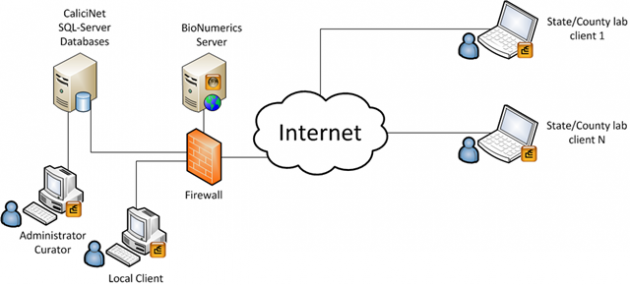Since the early 90's, an increasing number of foodborne outbreaks has been investigated by national health services worldwide. Typing of all isolates in real-time became impossible, and it was decided to decentralize typing activities of bacterial and viral pathogens. Nowadays, worldwide molecular surveillance networks for bacterial (Salmonella, E. coli & Shigella, Campylobacter spp., Listeria monocytogenes, Vibrio cholerae, Vibrio parahaemolyticus, Yersinia pestis, etc.) and viral pathogens (norovirus) are in place to facilitate the detection and investigation of outbreaks. In addition to standardized typing protocols, it is essential to have access to electronic databases in which clients can share and exchange typing patterns with the surveillance networks.
BIONUMERICS features for surveillance networks
The advanced client-server features and flexibility of BIONUMERICS form the perfect backbone for setting up and maintaining multi-user databases and analysis platforms required for surveillance networks.
- Share and exchange data between users, databases, and laboratories.
- Upload and download database entries, interactive querying, create comparisons and dendrograms, automatic identification of profiles uploaded by the client.
- Comprehensive user and security tools to keep the database clean and manageable. Create User Groups and Users with logins and passwords. Make central databases available to a restricted or unrestricted number of client users. Specify privileges and log user activity, etc.
- Design customized scripts and database management tools for sophisticated implementations in your network (e.g. automatic generate reports or alerts to members in the surveillance network).
- Record all changes to any database object in audit trails in compliance with the strictest Good Manufacturing Practice regulations.
International surveillance networks that have integrated the BIONUMERICS software:
- PulseNet International: Network of national and regional laboratories dedicated to tracking bacterial foodborne infections. Standardized protocols for PFGE and MLVA analysis in BIONUMERICS are available on the PulseNet International website.
- The European Surveillance System (TESSy): Network for data analysis and production of outputs for public health action. TESSy website.
- CaliciNet: An outbreak surveillance network for noroviruses in the United States. CaliciNet website.
- And many more...
Data exchange model for CaliciNet:

